 A deceptively 3-story building. Simple yet not so.
A deceptively 3-story building. Simple yet not so.Whopper Buidling, by Hitoshi Abe, Sentai, Japan.
Making Connections
 This's why Peter is a famous architect. Way to go Corrie.
This's why Peter is a famous architect. Way to go Corrie. Digital rendering becomes art, or vice-versa, by artist Giacomo Costa.
Digital rendering becomes art, or vice-versa, by artist Giacomo Costa.
 Wind turbines are cool, but how about shading your full-height curtain wall?
Wind turbines are cool, but how about shading your full-height curtain wall?
 Jump Studio has designed a few Denari-like interior in London, but the Red Bull’s London HQ comes with a built-in slide between floors as a way to “manifest an adrenalin and dynamic excitement", and simply encourage movement by its occupants. True to the brand indeed.
Jump Studio has designed a few Denari-like interior in London, but the Red Bull’s London HQ comes with a built-in slide between floors as a way to “manifest an adrenalin and dynamic excitement", and simply encourage movement by its occupants. True to the brand indeed.
 I am always depressed by “eyesores” beside freeway (like Riverside: great hospital, horrible building, drives me crazy) Can you imagine driving on the freeway and see this acoustical barrier merged with an auto dealership? Designed by Oosterhuis in NL for Hessing in Utrecht.
I am always depressed by “eyesores” beside freeway (like Riverside: great hospital, horrible building, drives me crazy) Can you imagine driving on the freeway and see this acoustical barrier merged with an auto dealership? Designed by Oosterhuis in NL for Hessing in Utrecht.
 I was very much intrigued by this image when I first saw it. What is it doing on an architecture website? It is an interesting project that combines SANAA’s diagrammatic approach and H&dM’s building-skin-equals-architecture strategy. A fun website too: Mansilla+Tuñón, Spain.
I was very much intrigued by this image when I first saw it. What is it doing on an architecture website? It is an interesting project that combines SANAA’s diagrammatic approach and H&dM’s building-skin-equals-architecture strategy. A fun website too: Mansilla+Tuñón, Spain. A strange (but probably marketing oriented) feature of this year’s Denmark pavilion at Biennial in Venice. It is a partnership between 4 Danish design firms with 4 Chinese universities, to tackle the urban and environmental challenges ahead of China’s growth.
A strange (but probably marketing oriented) feature of this year’s Denmark pavilion at Biennial in Venice. It is a partnership between 4 Danish design firms with 4 Chinese universities, to tackle the urban and environmental challenges ahead of China’s growth. Tom Dixon’s first piece of architecture, the Tokyo Hipsters’ Club, is a big deal in industrial design world. The legendary self-educated/trained British industrial designer who just won the prestigious Designer of the Year Award by Design Museum in London, is excited to venture into architecture. His comment on architecture is quite revealing, he said recently in an interview with magazine Pol Oxygen, “People like to pretend [architecture] is difficult. [Architects] create a sense of mystique around it but the truth is the difficult bit is the structural engineering, the boring bits are the rules and regulations, and the fun bit is creating shapes, which really isn’t all that difficult.” It is easier said than done. His THC is very much a concrete box with interesting retail design within. We will have to wait and see how easy is creating shapes for Dixon in his next project.
Tom Dixon’s first piece of architecture, the Tokyo Hipsters’ Club, is a big deal in industrial design world. The legendary self-educated/trained British industrial designer who just won the prestigious Designer of the Year Award by Design Museum in London, is excited to venture into architecture. His comment on architecture is quite revealing, he said recently in an interview with magazine Pol Oxygen, “People like to pretend [architecture] is difficult. [Architects] create a sense of mystique around it but the truth is the difficult bit is the structural engineering, the boring bits are the rules and regulations, and the fun bit is creating shapes, which really isn’t all that difficult.” It is easier said than done. His THC is very much a concrete box with interesting retail design within. We will have to wait and see how easy is creating shapes for Dixon in his next project. Thailand design firm, Trimode Studio, designed this perforated chair called “Koop” somewhat Asian, yet highly architectural (and probably not very comfortable).
Thailand design firm, Trimode Studio, designed this perforated chair called “Koop” somewhat Asian, yet highly architectural (and probably not very comfortable).
 Can we turn leaves into architecture? Why? Because we can?
Can we turn leaves into architecture? Why? Because we can? If you don’t want to trash your spam, you can turn it into architecture. Alex Dragulescu from Romania created a program that turns spam into 3-dimensional models. While these are not “livable” architecture, you can at least sell them as images.
If you don’t want to trash your spam, you can turn it into architecture. Alex Dragulescu from Romania created a program that turns spam into 3-dimensional models. While these are not “livable” architecture, you can at least sell them as images.

 Denari is more known for his “continuous” surface, which now becomes so ubiquitous. This time, sponsored by Bartco Lighting, he created an object that is more minimalist sculpture/structure than space. I am not sure if there is any reference to Dan Flavin’s work. But the idea of taking what we used to see in grocery stores and big box retail, the standard fluorescent tubes and make them into such an intriguing installation is quite incredible.
Denari is more known for his “continuous” surface, which now becomes so ubiquitous. This time, sponsored by Bartco Lighting, he created an object that is more minimalist sculpture/structure than space. I am not sure if there is any reference to Dan Flavin’s work. But the idea of taking what we used to see in grocery stores and big box retail, the standard fluorescent tubes and make them into such an intriguing installation is quite incredible. Norway-born digital/video artist Niko Stumpo has done some amazing abstract “thing” (because I don’t really know how to name it). Its floral quality reminds me of the Art Nouveau aesthetics…
Norway-born digital/video artist Niko Stumpo has done some amazing abstract “thing” (because I don’t really know how to name it). Its floral quality reminds me of the Art Nouveau aesthetics… Hard to believe, but these images aren't photoshopped. They are actually original photographs from Angus Brown, an artist featured previously in Wired Magazine. They are taken through a process called synchroballistic photography. In it, the subject and photographer are moving in the same direction at a similar speed, thus the subject becomes slightly warped and the background becomes indiscernible. What is perhaps most interesting relative to this method from an architectural frame, is the dialogue it sets up relative to the figure/ground argument - that being in some cases the subject is subsumed by, or synchronized to the background through motion, and visa versa.
Hard to believe, but these images aren't photoshopped. They are actually original photographs from Angus Brown, an artist featured previously in Wired Magazine. They are taken through a process called synchroballistic photography. In it, the subject and photographer are moving in the same direction at a similar speed, thus the subject becomes slightly warped and the background becomes indiscernible. What is perhaps most interesting relative to this method from an architectural frame, is the dialogue it sets up relative to the figure/ground argument - that being in some cases the subject is subsumed by, or synchronized to the background through motion, and visa versa.  For some reason, twisted tower is becoming very popular in architecture in recent years, from SOM’s early version of the Freedom Tower, to Calatrava’s Melmö in Sweden. H&dM’s new Roche Tower in Basel takes an asymmetrical approach which is quite interesting.
For some reason, twisted tower is becoming very popular in architecture in recent years, from SOM’s early version of the Freedom Tower, to Calatrava’s Melmö in Sweden. H&dM’s new Roche Tower in Basel takes an asymmetrical approach which is quite interesting. How to deal with existing historical structure is often a tough task for the “modernists”. This is an exception. SeARCH is one of the Dutch firms feature in Taschen’s new Architecture in the Netherlands.
How to deal with existing historical structure is often a tough task for the “modernists”. This is an exception. SeARCH is one of the Dutch firms feature in Taschen’s new Architecture in the Netherlands. One of the 10 finalist entries to the master-planning competition in Singapore called “Garden by the Bay” by Ah’be Landscape Architects and George Yu Architects, it is another way to merge landscape and architecture called “manifold”.
One of the 10 finalist entries to the master-planning competition in Singapore called “Garden by the Bay” by Ah’be Landscape Architects and George Yu Architects, it is another way to merge landscape and architecture called “manifold”. I have to say the new lines of Samonite are quite nice (and expensive too). The one designed by Newson is very much along the design when he did the 021C concept car for Ford, not so much of my favorite Felt Chair. More on Newson, see Design Museum UK’s designers profile.
I have to say the new lines of Samonite are quite nice (and expensive too). The one designed by Newson is very much along the design when he did the 021C concept car for Ford, not so much of my favorite Felt Chair. More on Newson, see Design Museum UK’s designers profile.
 Cai Guo Qiang, one of the well known Chinese artists outside China. He has done a lot of installation and performance art all over the world about some kind of abstract symbolism. I found this “Borrowing Your Enemy’s Arrows” very interesting. It is the famous “Battle of Red Cliff (Chi Bi)” during the Three Kingdoms (San-Guo) period in Chinese history, where a weaker army was able to defeat the stronger by a clever tactic of sending boats with grass-stuffed figures into the enemy’s territory and collected the arrows for use as weapons.
Cai Guo Qiang, one of the well known Chinese artists outside China. He has done a lot of installation and performance art all over the world about some kind of abstract symbolism. I found this “Borrowing Your Enemy’s Arrows” very interesting. It is the famous “Battle of Red Cliff (Chi Bi)” during the Three Kingdoms (San-Guo) period in Chinese history, where a weaker army was able to defeat the stronger by a clever tactic of sending boats with grass-stuffed figures into the enemy’s territory and collected the arrows for use as weapons. Talking about being iconic and humorous... BIG from Copenhagen is more Dutch than, say, Neutelings-Riedijk.
Talking about being iconic and humorous... BIG from Copenhagen is more Dutch than, say, Neutelings-Riedijk.
 Green roof has become so popular that people are talking about the “next” green roof. How about a mere 2 inch thick, come in 500mm2 tiles, and you only have to mow once a year? Maybe we should think about putting them in the backyard than on the roof.
Green roof has become so popular that people are talking about the “next” green roof. How about a mere 2 inch thick, come in 500mm2 tiles, and you only have to mow once a year? Maybe we should think about putting them in the backyard than on the roof.
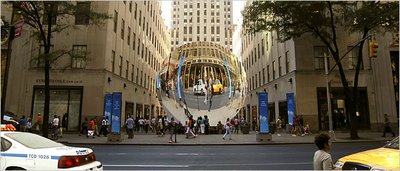 (India-born, UK sculptist) Anish Kapoor, (mostly known in the U.S. by “Cloud Gate” in Chicago’s Millennium Park opened last year) is planning to install yet another huge public art in NYC. This time in front of Rockefeller Center, the piece titled “Sky Mirror” (first installed in Nottingham Playhouse, UK in a smaller scale) is a 3-story high, contact-lens-like stainless steel, highly reflective to mirror the street life around as if it is through a drop of water. Kapoor’s work is famous for their contrasting qualities: material vs. immaterial; weight vs. weightless; tangible vs. intangible… Nevertheless, we should all take time to reflect, once a while.
(India-born, UK sculptist) Anish Kapoor, (mostly known in the U.S. by “Cloud Gate” in Chicago’s Millennium Park opened last year) is planning to install yet another huge public art in NYC. This time in front of Rockefeller Center, the piece titled “Sky Mirror” (first installed in Nottingham Playhouse, UK in a smaller scale) is a 3-story high, contact-lens-like stainless steel, highly reflective to mirror the street life around as if it is through a drop of water. Kapoor’s work is famous for their contrasting qualities: material vs. immaterial; weight vs. weightless; tangible vs. intangible… Nevertheless, we should all take time to reflect, once a while.
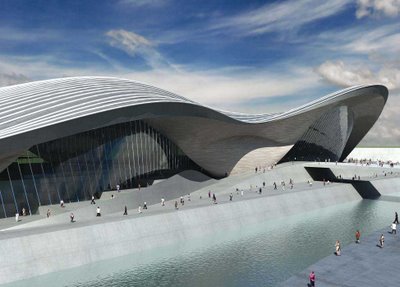
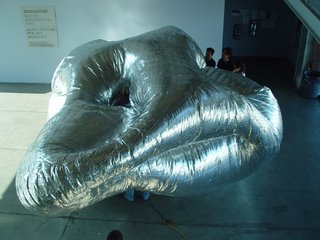
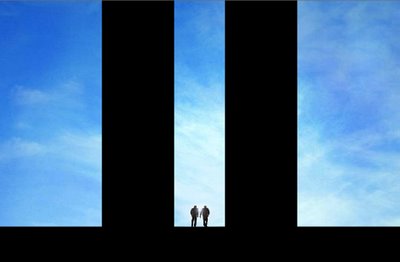 Given the Heathrow’s liquid bomb threat last week, here is an interesting blog on World Changing about “Why sustainability, not terrorism, should be the security focus”. In his post, Steffen argued that the climate crisis and environmental degradation we are facing is by far a much large threat to us than the occasional terrorist plots… It sounds right, but I am wondering, why we choose or allow these supposedly ineffective wars on terror that there are very few convincing evident that we are in a more secure and safer place than 5 years ago. Is it because it is easier to “fight” terror with a very clear target and we are the good guys and they are the bad guys? Is it because terrorism deals with fear, not necessarily fact or evidence? Or is it because there are no obvious evils in sustainability? Because we are all kind of guilty?
Given the Heathrow’s liquid bomb threat last week, here is an interesting blog on World Changing about “Why sustainability, not terrorism, should be the security focus”. In his post, Steffen argued that the climate crisis and environmental degradation we are facing is by far a much large threat to us than the occasional terrorist plots… It sounds right, but I am wondering, why we choose or allow these supposedly ineffective wars on terror that there are very few convincing evident that we are in a more secure and safer place than 5 years ago. Is it because it is easier to “fight” terror with a very clear target and we are the good guys and they are the bad guys? Is it because terrorism deals with fear, not necessarily fact or evidence? Or is it because there are no obvious evils in sustainability? Because we are all kind of guilty?
 I saw this on Re. the other day. Belgian designer Xavier Lust showcased an effective way to create very sculptural and dynamic furniture at the Mode Design Brussels.
I saw this on Re. the other day. Belgian designer Xavier Lust showcased an effective way to create very sculptural and dynamic furniture at the Mode Design Brussels. An interesting story on BusinessWeek about Patagonia, an outdoor clothing and equipment company, headquarter in California with 39 stores in 7 countries. Yvon Chouinard is the founder and chairman of Patagonia, who wrote a book called Let My People Go Surfing as a manifesto of sustainable business practice. The 1275-employee, $240 millions revenue-per-year company has a simple yet challenging mission: to produce the highest-quality products while doing the least possible harm to the environment. Are they just hollow words? How about a 2-month full pay sabbatical for employees who choose to work for environmental groups as volunteers (among other things)? The result is a highly motivated and passionate workforce who is not only in for the money but higher ideals, which in turn provides an edge in a highly competitive apparel market. Not a bad company to learn from…
An interesting story on BusinessWeek about Patagonia, an outdoor clothing and equipment company, headquarter in California with 39 stores in 7 countries. Yvon Chouinard is the founder and chairman of Patagonia, who wrote a book called Let My People Go Surfing as a manifesto of sustainable business practice. The 1275-employee, $240 millions revenue-per-year company has a simple yet challenging mission: to produce the highest-quality products while doing the least possible harm to the environment. Are they just hollow words? How about a 2-month full pay sabbatical for employees who choose to work for environmental groups as volunteers (among other things)? The result is a highly motivated and passionate workforce who is not only in for the money but higher ideals, which in turn provides an edge in a highly competitive apparel market. Not a bad company to learn from…
 Talking with J.No yesterday about boxes and Morphosis (and some others). Morphosis is one of my early heroes when I only knew Mies, Corbu and those “first generation” modernists. I knew little about PoMo, Decon and boom, I was like, you can do that? I was attracted to Mayne’s work not because I got it, but because it was cool, pieces flying in the air. It was the rock-n’-roll architecture. Like music, this happens almost entirely on the emotional level with very little intellectual satisfaction. Can we learn from (or at least copy) it? Is it about contemporary society becoming ambiguous in every way that there are always layers of information on top of one another? Is it about form folding and fragmenting in movement to suggest… shall we say… change? Or is it manifestation of post-modernity (not pomo) without Eisenman’s BS? It seems that architects take many forms and approaches, and at the end of the day, it is as much internal as external influence. Maybe it is the integrity and persistency that matters most, not so much the “right” ideas.
Talking with J.No yesterday about boxes and Morphosis (and some others). Morphosis is one of my early heroes when I only knew Mies, Corbu and those “first generation” modernists. I knew little about PoMo, Decon and boom, I was like, you can do that? I was attracted to Mayne’s work not because I got it, but because it was cool, pieces flying in the air. It was the rock-n’-roll architecture. Like music, this happens almost entirely on the emotional level with very little intellectual satisfaction. Can we learn from (or at least copy) it? Is it about contemporary society becoming ambiguous in every way that there are always layers of information on top of one another? Is it about form folding and fragmenting in movement to suggest… shall we say… change? Or is it manifestation of post-modernity (not pomo) without Eisenman’s BS? It seems that architects take many forms and approaches, and at the end of the day, it is as much internal as external influence. Maybe it is the integrity and persistency that matters most, not so much the “right” ideas.
 The long publicized LivingHomes (designed by Ray Kappe) was recently completed in Santa Monica. LA Times has an article about it and the future (and present) of prefab houses. In terms of cost, these high profile prefabs are still way above “typical” houses we find in our neighborhood, close to $300/SF (not including land cost and site work). Yes, the quality is higher, with green roof and solar panels, and it can be built much faster but mainstream? Maybe we need to team up with Target to figure out how to make good design affordable for everyone. I heard IKEA is selling houses in Sweden now…
The long publicized LivingHomes (designed by Ray Kappe) was recently completed in Santa Monica. LA Times has an article about it and the future (and present) of prefab houses. In terms of cost, these high profile prefabs are still way above “typical” houses we find in our neighborhood, close to $300/SF (not including land cost and site work). Yes, the quality is higher, with green roof and solar panels, and it can be built much faster but mainstream? Maybe we need to team up with Target to figure out how to make good design affordable for everyone. I heard IKEA is selling houses in Sweden now…
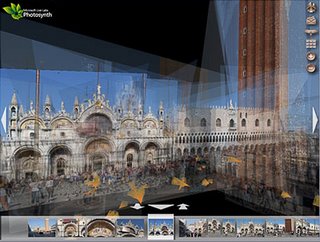
Thanks Mark Ours and Lindsay Kenzig for this link.
From the website: "Photosynth is an amazing new technology from Microsoft Live Labs that will change the way you think about digital photos forever..."
 Tate Modern announced its new plan to expand the most popular crowded modern art museum in the world. Tate Modern’s 4.1 million visitors a year well passed Pompidou (2.1 million) and MoMA (2.7 million) (as Guardian reports).
Tate Modern announced its new plan to expand the most popular crowded modern art museum in the world. Tate Modern’s 4.1 million visitors a year well passed Pompidou (2.1 million) and MoMA (2.7 million) (as Guardian reports).